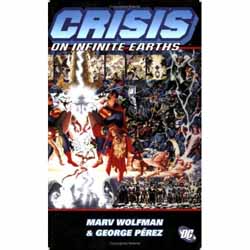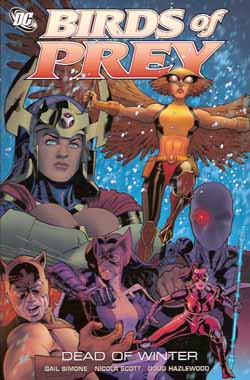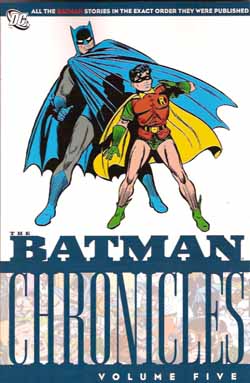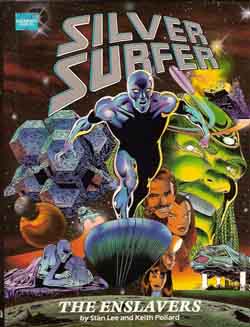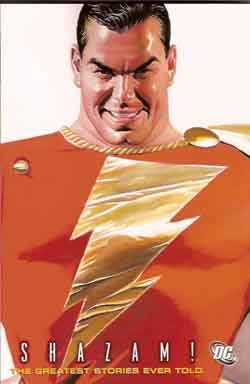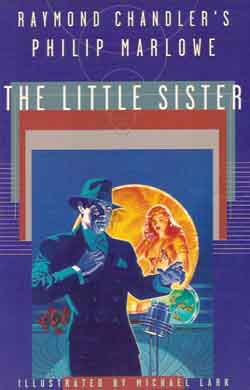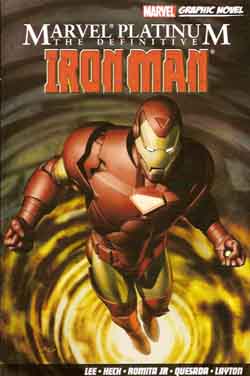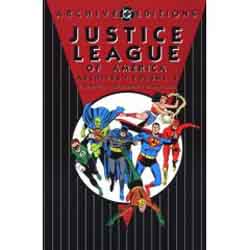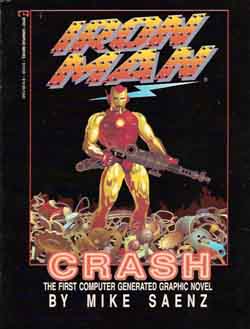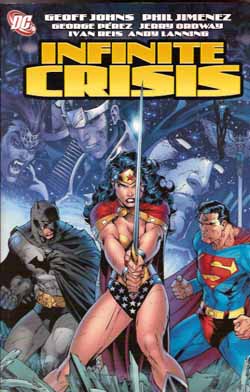
By Geoff Johns, Phil Jimenez & various (DC Comics)
ISBN: 978-1-4012-0959-9
If you’re not a fan or follower of superheroes or extreme continuity comics, you might want to just skip this book: Otherwise be prepared for some fairly complex fight-in-tights interplay. Also, don’t even think about attempting this without first reading Crisis on Infinite Earths (ISBN: 978-1-5638-9750-4)!
Still with us? Okay, then…
To celebrate the anniversary of the biggest comics event of the 1980s, DC decided to revisit Crisis on Infinite Earths and boost sales and media exposure with another End-of-Everything mega-crossover. Out of this premise would come a cascade of tie-in titles, entwined storylines and a continuous high level of follow-up events, One Year Later, 52, Countdown, etcetera ad nauseum. Every character in the DCU must be permanently tanked on tranquilisers these days…
Spoiler Alert: I’m about to blow the ending of Crisis on Infinite Earths so if you still haven’t read it, do it now or deal with the consequences.
After a cataclysmic battle at the dawn of time all the remaining alternate universes were combined into one. Barring some continuity after-shocks, life itself was saved and reality was returned to its natural progress. Four remnants from worlds that had now never existed – Superman and Lois Lane from Earth 2, Alexander Luthor from Earth 3 and Superboy from Earth Prime, departed Reality itself for a nebulous, paradisiacal other place and the universe continued on.
As DC restarted its heroic history disquieting anomalies occasionally manifested, but generally everything progressed smoothly – as much as it can in superhero comics. But as the years passed the stories and events became grimmer, grittier, altogether darker and nastier. Superman was killed by Doomsday and came back (The Death and Return of Superman Omnibus ISBN: 978-1-4012-1550-7), opening the doorway of death for other returnees. The Justice League lobotomised Dr. Light (see Identity Crisis ISBN: 1-34576-126-X), Wonder Woman executed the telepathic despot Maxwell Lord (Superman: Sacrifice ISBN: 1-84576-243-6) and Batman had become a paranoid sociopath.
Heroes had become indistinguishable from villains, and in a place beyond space and time four survivors of a different kind of Reality looked on in horror and despair. Observing such events the last denizens of the multiverse realised that a dreadful mistake had been made and it was up to them to rectify it…
The seven issues of Infinite Crisis brought together all the various threads of various DCU titles as young Luthor, Superboy Prime and Mr and Mrs Superman tried in their own ways to unpick and reweave the fabric of a universe they deemed faulty. The attendant books Day of Vengeance (ISBN 1-84576-230-4) The Omac Project (ISBN 1-84576-229-0) Rann-Thanagar War (ISBN 1-84576-231-2) and Villains United (ISBN 1-84576-232-0) iterate their earliest clandestine efforts, funnelling into and culminating in this rather messy, unwieldy epic (as do storylines from a host of other individual titles) and after cataclysmic events a reality is salvaged if not actually saved.
For safety’s sake you’d best also include the Infinite Crisis Companion (ISBN: 978-1-48576-378-7) and Superman: Infinite Crisis (ISBN: 978-1-84576-342-8) on your shopping list if you’re going to attempt this ambitious but unnecessarily complex magnum opus which aims so very high and nearly achieves all it set out to.
Concocted by Geoff Johns and Phil Jimenez, assisted by George Pérez, Jerry Ordway, Ivan Reis and Andy Lanning, this is tantalisingly close to being a classic, but the muddle and bombast are only really accessible to the already conversant hardened fan whilst the new readers that came in the wake of the hype, (unlike the better structured Crisis on Infinite Earths) must have been left reeling by the overwhelming intricacy here, not to mention the frankly boggling number of characters in play without any seeming purpose or narrative contribution.
Like its predecessor this story will inform all DC adventures for years to come so it’s pretty much compulsory reading for fans, and to be fair, it is beautiful and impressive to look upon, but my major concern – as always – is getting more people reading comics and this one is just too much like hard work for the fresh and inexperienced punter.
© 2005, 2006 DC Comics. All Rights Reserved.

